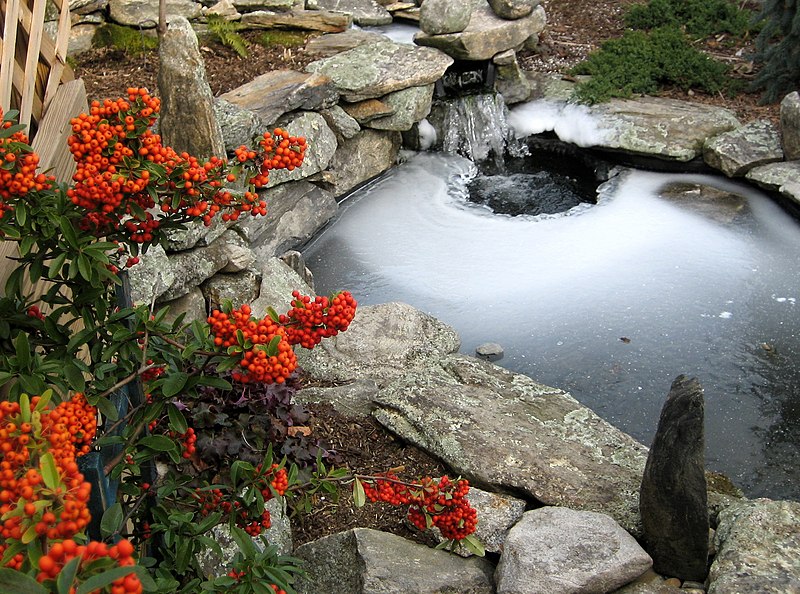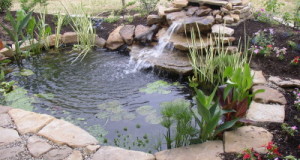 Say what you will about the changing of seasons, getting to watch the leaves turn from green to shades of red and yellow, and partaking in what are arguably the best holidays of the year (Halloween, Thanksgiving, and that one where we all go shopping), but going into winter is a pain in the pond! Well, this blogger is here to help you overcome your winter-time woes with some helpful reminders of how to get your outdoor pond ready for the winter.
Say what you will about the changing of seasons, getting to watch the leaves turn from green to shades of red and yellow, and partaking in what are arguably the best holidays of the year (Halloween, Thanksgiving, and that one where we all go shopping), but going into winter is a pain in the pond! Well, this blogger is here to help you overcome your winter-time woes with some helpful reminders of how to get your outdoor pond ready for the winter.
Now, obviously we don’t all live in the same climate; so this blog will likely only be helpful for folks who actually get to experience a winter and all the glorious tribulations it has to offer: freezing weather, snow showers, etc. Those of you lucky enough to only need a light jacket through winter months can move right along with your “lows in the 60’s” weather! If, on the other hand, you actually own a snow shovel, then let’s work on getting that pond ready for the winter with 4 easy-to-follow steps:
Ice is bad, m’kay?
One of the worst things you can let your pond do is completely freeze over when the temperatures drop. If there is no opening in the ice, then there is no gas exchange going on. Your fish might be hibernating, but they still need oxygen to breathe and your pond still needs to release carbon dioxide. Does the whole pond need to be ice free? Of course not! A little hole in the ice would be satisfactory. This can be accomplished two ways: by using an air pump or a de-icer.
Air pumps pump air into the pond, creating bubbles to disrupt the surface of the water and preventing ice from forming. Air pumps are also a nice investment because they are useful in the summer for extra oxygenation when the temperatures rise.
The alternative is a pond de-icer. Do I mean a pond heater? No, not really. A heater would heat the whole pond to temperatures above freezing, and that would be really expensive. All you need is a hole in the ice, and a de-icer creates one. These generally circular devices, such as the Thermo-pond or Perfect Climate to name a few, produce enough heat to keep ice from forming around them, allowing the gases to exchange. Manufacturers list the size pond their de-icer is capable of handling on the packaging, and just like everything else electronic, some de-icers are more efficient than others. As a point of reference 200 watts will keep a large enough hole open for ponds up to a few hundred gallons, the higher the wattage the larger the hole. It doesn’t hurt to go a little bigger sometimes, but by no means is it absolutely necessary.
 Please note that de-icers don’t last forever, but with proper care and understanding you can keep your de-icer running efficiently for several seasons. Make sure to read the manufacturer’s suggestions on appropriate care so your de-icer, which often include not allowing calcium deposits to build up on the heating coils, not allowing snow to pile up on the de-icer, and not using an extension cord to run the unit. If there is a weird warm-spell in the middle of winter, take your de-icer out of the pond and put it in the freezer for 30 minutes to reset the thermostat before it gets cold again. I’m sure some of you out there are asking “can’t I just leave my filter/pump/waterfall running all winter?” Well, yes, you could. But, coming from someone who has worked in this industry for as long as I have, it’s usually not worth the risk. I have heard many-a-story told about pumps dying, filters freezing, waterfalls draining ponds, and ultimately fish dying. Which leads us to my next tip:
Please note that de-icers don’t last forever, but with proper care and understanding you can keep your de-icer running efficiently for several seasons. Make sure to read the manufacturer’s suggestions on appropriate care so your de-icer, which often include not allowing calcium deposits to build up on the heating coils, not allowing snow to pile up on the de-icer, and not using an extension cord to run the unit. If there is a weird warm-spell in the middle of winter, take your de-icer out of the pond and put it in the freezer for 30 minutes to reset the thermostat before it gets cold again. I’m sure some of you out there are asking “can’t I just leave my filter/pump/waterfall running all winter?” Well, yes, you could. But, coming from someone who has worked in this industry for as long as I have, it’s usually not worth the risk. I have heard many-a-story told about pumps dying, filters freezing, waterfalls draining ponds, and ultimately fish dying. Which leads us to my next tip:
Turn off and remove your pumps and filters
Year after year fish store employees are bombarded by folks needing replacement pumps and filters in the dead of winter because Jack Frost finally got to them. It’s just not worth it! Let me explain. In the winter time, slightly warmer water can be found at the bottom of the pond (which is why your fish hibernate there). Your pump is likely also at the bottom of your pond. When the pump draws that warm water from the bottom of the pond and exposes it to the cold winter air, it cools the water even more. Now, unless you plan on crocheting little sweaters for your fish, this is not desirable.
If you remember back to grade school science class, water expands as it turns from liquid to solid. If your pump dies, snow takes out a power line, or any other number of other freak instances occur, then external filters, external pumps, UV sterilizers, and plumbing could all be ruined by ice expanding and cracking their poor, plastic bodies. I see it every year. Be proactive and unplug your pump, pull out your filters, detach your UV’s and take them inside where there can be emptied of water and gunk from the long summer. It might not happen to you, but I can guarantee that a de-icer is less expensive than any one of the key components making up your pond filtration. Plus, the winter is a great time to give your equipment the careful inspection it needs so you can be sure everything is functioning properly and simply to just give everything a good scrubbing.
Do that water change now, before it gets any colder!
The dreaded water change. I know, it’s a total pain. But it is really beneficial for the pond. Here’s why: filth in your pond can kill your fish. It’s as simple as that. Decaying organic matter left on the bottom of the pond can ruin water quality over the winter when there is not as much biological activity going on. Debris releases acids, such as humic acid, which can and will drop your pH and it will lead to algae and clarity issues when the weather warms back up. I recommend doing a water change on your pond at least twice a year (once before you start the pond in Spring, and once before you close it in the late Fall). Partially drain the pond using a pond-vac to get all that nasty, leafy gunk off of the bottom, and throw a pond net (such as the Pond-Master PVC mesh nets) over the pond to keep leaves out. Personally, I also like using Microbe-Lift’s Autumn/Winter Prep product to keep the biological filter healthy all winter long. It’s a blend of enzymes and cold-weather tolerant bacteria that can actually live in temps below 40°F.
Change Foods
 As the temperatures fall, your fish begin to go slow down and enter dormancy. Before they officially zonk-out for the winter you may be tempted to continue their regularly scheduled feedings. For the sake of your fish, make sure you switch their diet from their current staple pellets to an autumn/winter pellet. Cold-weather foods are heavy on wheat-germ and lower in protein content which makes them quick and easy to digest. The natural bacteria of your fish’s intestines continue to break down the food. These bacteria release gases which can lead to bloating and bacterial infections.
As the temperatures fall, your fish begin to go slow down and enter dormancy. Before they officially zonk-out for the winter you may be tempted to continue their regularly scheduled feedings. For the sake of your fish, make sure you switch their diet from their current staple pellets to an autumn/winter pellet. Cold-weather foods are heavy on wheat-germ and lower in protein content which makes them quick and easy to digest. The natural bacteria of your fish’s intestines continue to break down the food. These bacteria release gases which can lead to bloating and bacterial infections.
These four basic steps can make all the difference in your pond’s health. With a little bit of foresight, the transition into the winter months is rather simple. Remember, you will need to practically reverse this process when it comes to opening the pond in spring time, but we’ll leave those tips to the warmer months.
Pond in winter image referenced from wikipedia and originally posted by Muffet
 That Fish Blog – Aquarium Advice and Information
That Fish Blog – Aquarium Advice and Information


I have a 300 gal outdoor pond with a few goldfish and shebunkin and was recently give 2 red eared sliders from a neighbor..you mentioned draining the sludge from the bottom as part of fall maintenance but I’ve also read that the RES need the mud to burrow for hibernating.. the bottom of the pond is lined, so do I leave the sludge or put sand or something at the bottom for them to hibernate/ Brumate? I plan to use a de-icer and aerator this winter..-any tips?
Hi Marie, I checked with one of our reptile experts for you on this. Their response: Red Ear sliders do brumate and typically they do burrow into loose mud, leaves and vegetation at the bottom of the pond.
I would not suggest removing much of the sludge unless they have a good thick mud base even after removing some of the older sludge.
I like the idea of the pond deicer as they do come up occasionally and stick their heads out of the water, I’ve seen them at the pond up the road at around 50 degrees (and up) coming outside and basking on the logs. I used to walk up there and found it interesting that many of them did come out and bask at just fifty degrees.
The more natural the state of the pond the more likely it is that the turtles are going to come out of brumation ok in the spring, some weaker ones do not survive.
Let me know if they have more questions, I think removing some of the older sludge is a good idea but still try to have enough mud and leaves that the turtles can burrow themselves , some go in mud as deep as 1 to 2 feet.